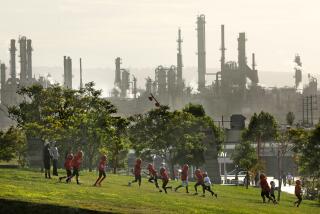FERC Claims Jurisdiction on Gas Plant
- Share via
Federal energy regulators said Thursday that they -- rather than California officials -- have the ultimate say over whether a proposed gas plant should be built in Long Beach, setting the stage for a jurisdictional tug-of-war over a plant that critics say could endanger nearby residents.
At stake is the building of onshore liquefied natural gas terminals in California as energy companies rush to build more than 30 such facilities nationwide.
The Federal Energy Regulatory Commission is responsible for where onshore California LNG plants are built, a spokesman said. “The siting of the facility is ours,” said Kevin Cadden, the agency’s director of external affairs, in a telephone interview from Washington, D.C.
But the California Public Utilities Commission claimed that responsibility this week in a move that worries supporters of the $400-million terminal that Mitsubishi wants to build at the Port of Long Beach.
Some city residents and environmental groups say they would feel more comfortable if California -- not the Bush administration -- scrutinized the proposal.
In another development, Long Beach City Atty. Robert E. Shannon said the City Council will take a position on the LNG plant. Earlier, officials said the council was not expected to vote on the proposed facility, which already is backed by the city’s port authority.
Some residents have complained that council members already gave tacit approval to the project by authorizing the city manager to start negotiations with Mitsubishi to buy its imported gas.
But, Shannon said Thursday, “There have been some very significant safety issues raised, and it’s very obvious that they need to be explored before anything substantive takes place here.”
The port has granted a Mitsubishi subsidiary, Sound Energy Solutions, the exclusive right to pursue plans to build the first such facility on the West Coast; four other terminals are operating in the United States.
No LNG terminals have been built in recent years. But rising gas prices and a declining domestic gas supply are driving new interest nationally in importing LNG from countries around the world. A number of other countries have imported LNG for decades.
To make LNG, exporters chill natural gas to minus 260 degrees Fahrenheit, transforming it into a clear liquid that takes up only a fraction of the space of the substance in gaseous form. That means it can be transported by ship rather than pipeline.
Mitsubishi would convert the LNG back to gas at the Long Beach terminal, producing 700 million cubic feet of natural gas each day.
Some city officials and environmentalists find the proposal particularly attractive because Mitsubishi also would provide LNG to fuel port yard equipment and other vehicles that currently burn diesel fuel, a suspected carcinogen.
The project attracted little public attention in Long Beach until a Jan. 19 explosion at an LNG export facility in Skikda, Algeria, killed 27 people.
Some scientists familiar with the highly flammable nature of LNG say they do not believe the terminals should be built within two to three miles of populated areas. Other scientists counter that modern LNG plants contain safeguards that would rule out a repeat here of the Algerian accident.
The federal energy board has promised to review the Long Beach plan carefully. But in a motion filed Monday with the agency, the state Public Utilities Commission raised questions about plant safety and the site’s proximity to earthquake faults.
In the motion, the state commission asserted its right under state and federal law to approve the project, and said it had been trying since October to make Mitsubishi apply for PUC certification. It also questioned whether the federal energy agency has jurisdiction over the project, because the facility would not provide interstate shipments of gas, which normally are regulated by the federal government.
However, Cadden, the FERC spokesman, said any facility used to import LNG falls under the agency’s jurisdiction. Asked if the state commission also has authority, Cadden said: “I wouldn’t presume to talk about what statutory authority California has.”
Thomas Giles, executive vice president of the Mitsubishi subsidiary, said the firm has no immediate comment on the dispute. “We haven’t had an opportunity yet to talk to FERC or fully understand what position FERC intends to take,” he said.
Patrick Power, an Oakland-based attorney specializing in utility affairs who represents the Long Beach-owned energy utility, said several projects proposed in Baja California could import LNG into California.
He said he was concerned that if the PUC entered the approval process, it could set in motion a series of events that “could have the unintended consequence of steering the outcome away from what would be the best project: the Long Beach project.”
He added that he was confident that federal regulators would not approve a project unless they thought it was safe.
More to Read
Inside the business of entertainment
The Wide Shot brings you news, analysis and insights on everything from streaming wars to production — and what it all means for the future.
You may occasionally receive promotional content from the Los Angeles Times.










